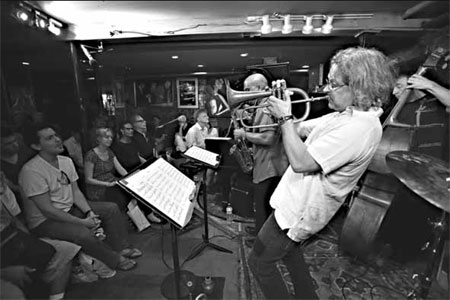Live jazz in the city, with a global reach
Updated: 2013-07-28 08:29
By Nate Chine(The New York Times)
|
|||||||
|
Smalls, a New York jazz club, offers free online streams of its shows. The trumpeter Alex Sipiagin recording a live album. Michelle V. Agins / The New York Times |
Smalls, the Greenwich Village jazz club, was packed on a recent night for the Alex Sipiagin Group's first set. Mr. Sipiagin, an exactingly skilled trumpeter, was celebrating the release of "Live at Smalls," his new post-bop album on the SmallsLIVE label, for an audience occupying the club's assortment of benches and bar stools, or standing around the back of the room.
Then there were those who took in the set from a glowing screen, hundreds or even thousands of kilometers away. Evan Cobb, a 32-year-old saxophonist, was watching a live feed on his computer in Nashville, Tennessee; Richard Dobbs, 55, a museum-store buyer who moonlights as a saxophonist, was doing the same in Cambridge, Massachusetts. "It's one of the better sets I've seen," Mr. Dobbs said later, comparing Mr. Sipiagin's performance to many others he has streamed through the club's Web portal, generally at no charge.
Several weeks ago Smalls, which opened in 1994 and soon became an essential laboratory and clubhouse for the New York jazz scene, announced an initiative to monetize its video and audio archives, creating an online subscription database with a revenue-sharing apparatus for musicians.
That model, which will be supported by a $60,000 fund-raiser, could be a bellwether for other jazz clubs. But because a permanent archive has different implications than an ephemeral stream, the issue has raised concerns among some musicians. Everyone seems to agree, though, that at a moment of accelerating media metabolisms and diminishing record sales, a new reality is inevitable.
If Smalls can be said to have a digital strategy, its architect is Spike Wilner, who has managed the club since 2007.
"When we started streaming six years ago it was really different technology," Mr. Wilner said. "We couldn't get a really clean signal going. Now, it's like you have a television studio in your club."
On his computer he was tracking the webcast, which was being watched as far away as South Africa, Russia and Brazil.
Live streaming has become a tool of outreach. Jazz at Lincoln Center in New York has made webcasts a priority since Greg Scholl became its executive director about a year ago, with 230 viewed from 172 countries. "There's a very large global market for jazz, but it's extremely diffuse," Mr. Scholl said.
What typically keeps an organization from opening its archives is a concern about licensing and publishing. Mr. Wilner devised the subscription model after hearing from musicians wary of ceding control of their music without fair pay.
"There was an uproar a year and a half ago," said the saxophonist Jon Gordon. "But guys were afraid to talk about it, because they wanted to keep working at the club."
Mr. Gordon helped organize an open dialogue: "I was part of a group of people that approached Spike and said, 'listen, you have to understand you're creating a difficult precedent here. If we do this for you, other clubs will expect this of us. You have a responsibility to create the paradigm going forward.'"
According to the proposal, Smalls will continue to provide free webcasts and release albums. The archives, though, will be accessible to those who pay an as-yet-unspecified monthly fee.
What's new about Mr. Wilner's plan is its proportional system of compensation. "At the end of each quarter, we're going to add up the total number of minutes each musician had been listened to," he said, and the pay will be on the basis of a percentage of total listening.
The subscription database may be a lifeline for the club.
"Our expenses are going through the roof," Mr. Wilner said. "We have a good business, but we have limited revenue in there: 60 seats, $20 cover, three bands, bartender, manager. So if I can generate a revenue stream from a worldwide audience that, say, pays our rent every month, then all of a sudden, we're chilling. We can pay the musicians more."
The breakdown of subscription revenue will surely come under scrutiny, but what's most evident at this stage is the frontier aspect of Mr. Wilner's enterprise, a spirit that feels true to the ethos of Smalls. As for the two saxophonists who watched the webcast, Mr. Dobbs said he planned to become a subscriber, while Mr. Cobb said he'd stick to the live stream.
"I'm more interested in just keeping up with what's happening as it's happening," Mr. Cobb said. "As far as dollars and cents for individual musicians, I'm sure everybody recognizes that it's going to be a little splash in the pot."
The New York Times
(China Daily 07/28/2013 page12)
